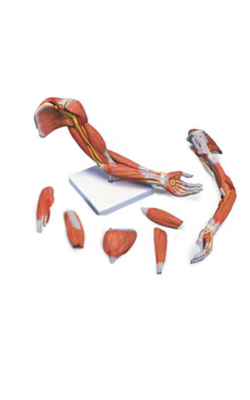Main Model

42 Median nerve

Median Nerve in Arm
The median nerve in the arm runs distally in the arm on the lateral side of the brachial artery until it reaches the middle of the arm, where it crosses to the medial side and contacts the brachialis. The median nerve then descends into the cubital fossa, where it lies deep to the bicipital aponeurosis and median cubital vein. The median nerve has no branches in the axilla or arm, but it does supply articular branches to the elbow joint.
Median Nerve in Forearm
The median nerve is the principal nerve of the anterior compartment of the forearm. It supplies muscular branches directly to the muscles of the superficial and intermediate layers of forearm flexors (except the flexor carpi ulnaris), and deep muscles (except for the medial [ulnar] half of the flexor digitorum profundus) via its branch, the anterior interosseous nerve.
The median nerve has no branches in the arm other than small twigs to the brachial artery. Its major branch in the forearm is the anterior interosseous nerve. In addition, the following unnamed branches of the median nerve arise in the forearm:
• Articular branches - These branches pass to the elbow joint as the median nerve passes it.
• Muscular branches - The nerve to the pronator teres usually arises at the elbow and enters the lateral border of the muscle. A broad bundle of nerves pierces the superficial flexor group of muscles and innervates the flexor carpi radialis, the palmaris longus, and the flexor digitorum superficialis.
• Anterior interosseous nerve - This branch runs distally on the interosseous membrane with the anterior interosseous branch of the ulnar artery. After supplying the deep forearm flexors (except the ulnar part of the flexor digitorum profundus, which sends tendons to 4th and 5th fingers), it passes deep to and supplies the pronator quadratus, then ends by sending articular branches to the wrist joint.
• Palmar cutaneous branch of the median nerve - This branch arises in the forearm, just proximal to the flexor retinaculum, but is distributed to skin of the central part of the palm.
Median Nerve in Hand
The median nerve enters the hand through the carpal tunnel, deep to the flexor retinaculum, along with the nine tendons of the flexor digitorum superficialis, flexor digitorum profundus, and flexor pollicis longus. The carpal tunnel is the passageway deep to the flexor retinaculum between the tubercles of the scaphoid and trapezoid bones on the lateral side and the pisiform and hook of the hamate on the medial side. Distal to the carpal tunnel, the median nerve supplies two and a half thenar muscles and the 1st and 2nd lumbricals. It also sends sensory fibers to the skin on the entire palmar surface, the sides of the first three digits, the lateral half of the 4th digit, and the dorsum of the distal halves of these digits. Note, however, that the palmar cutaneous branch of the median nerve, which supplies the central palm, arises proximal to the flexor retinaculum and passes superficial to it (i.e., it does not pass through the carpal tunnel).